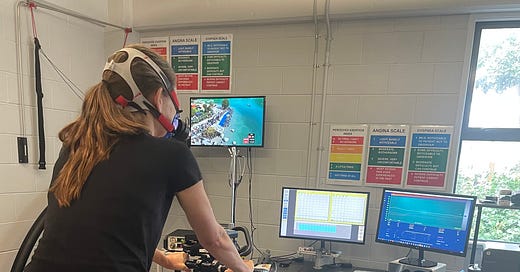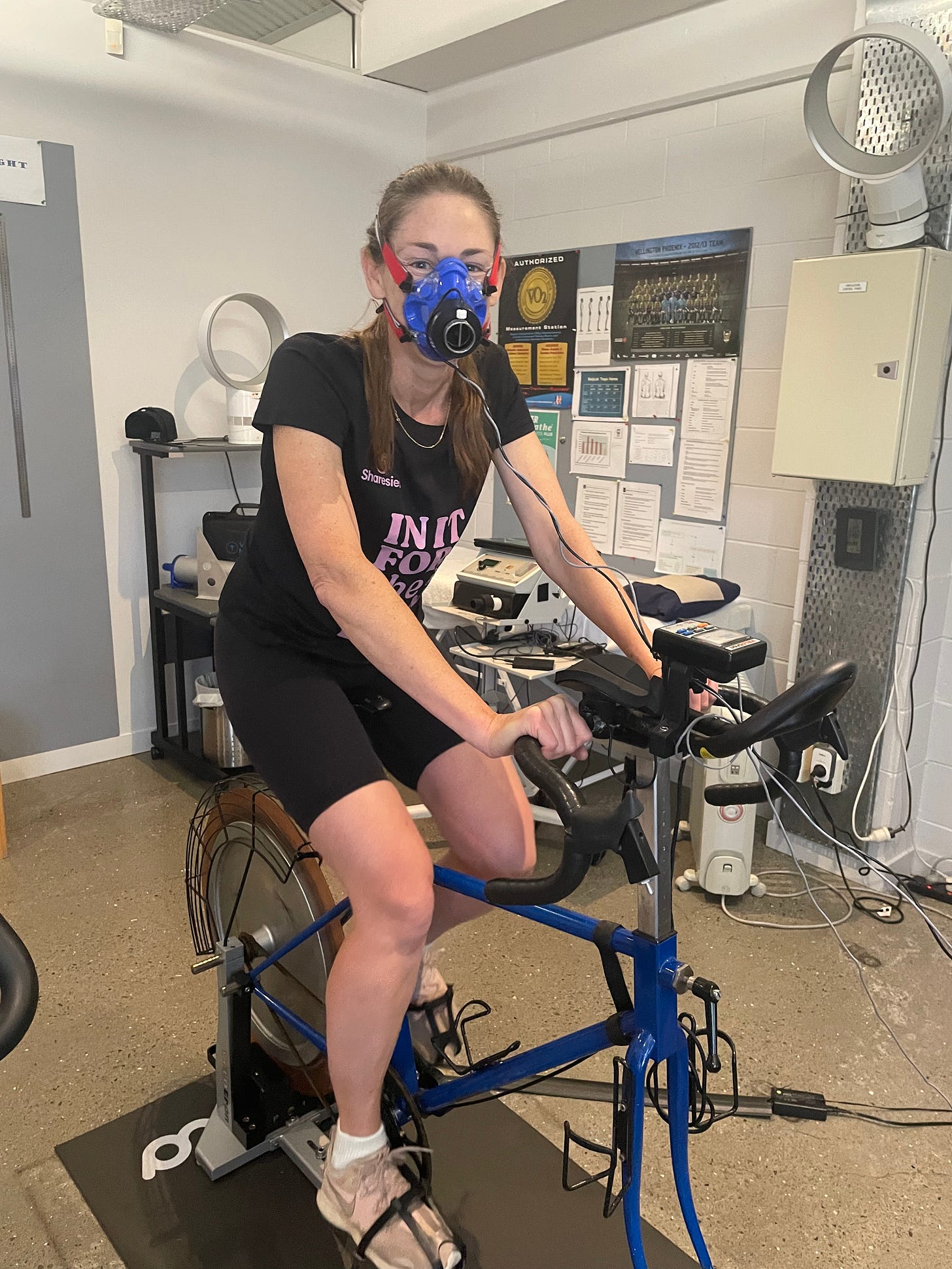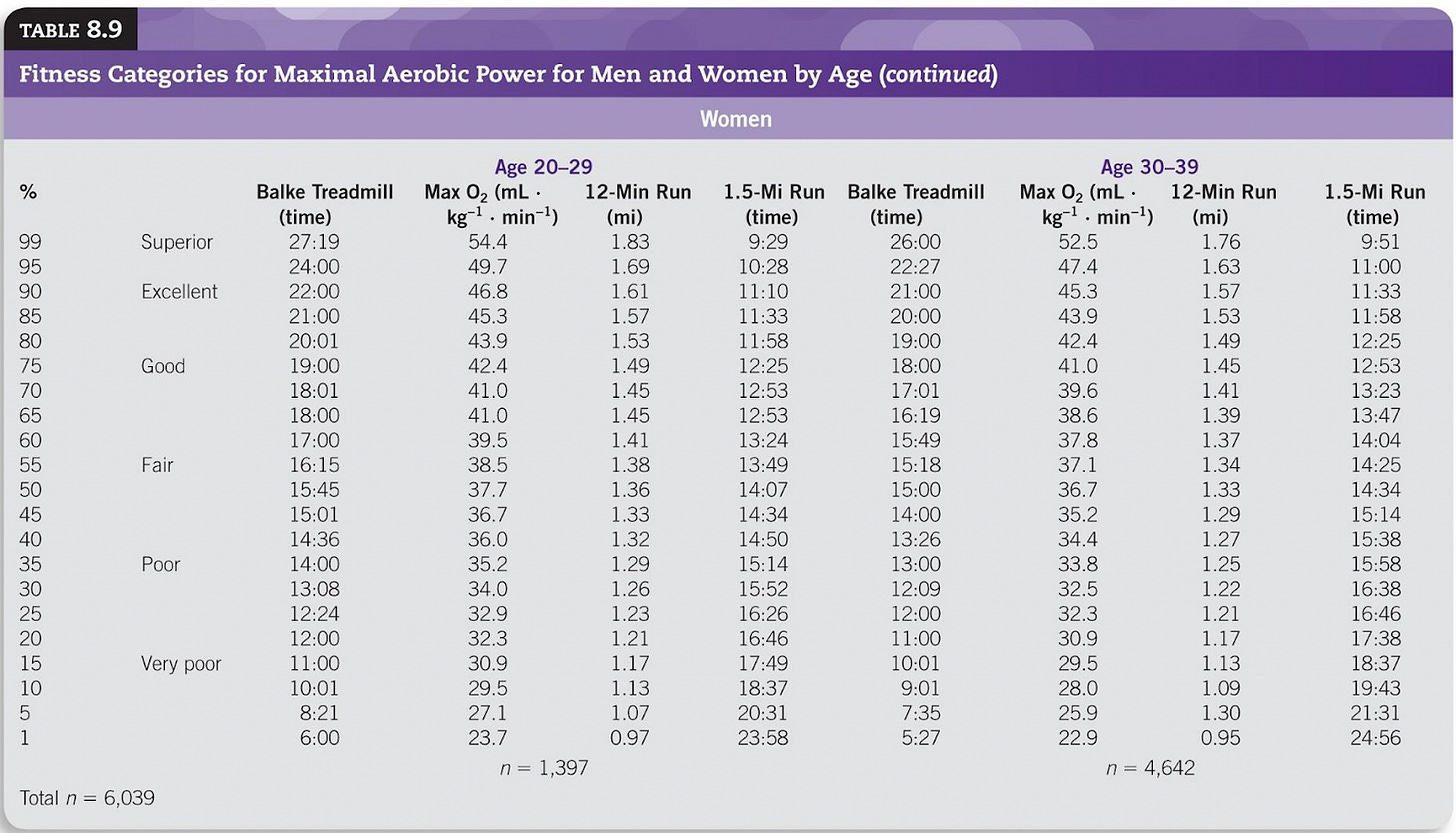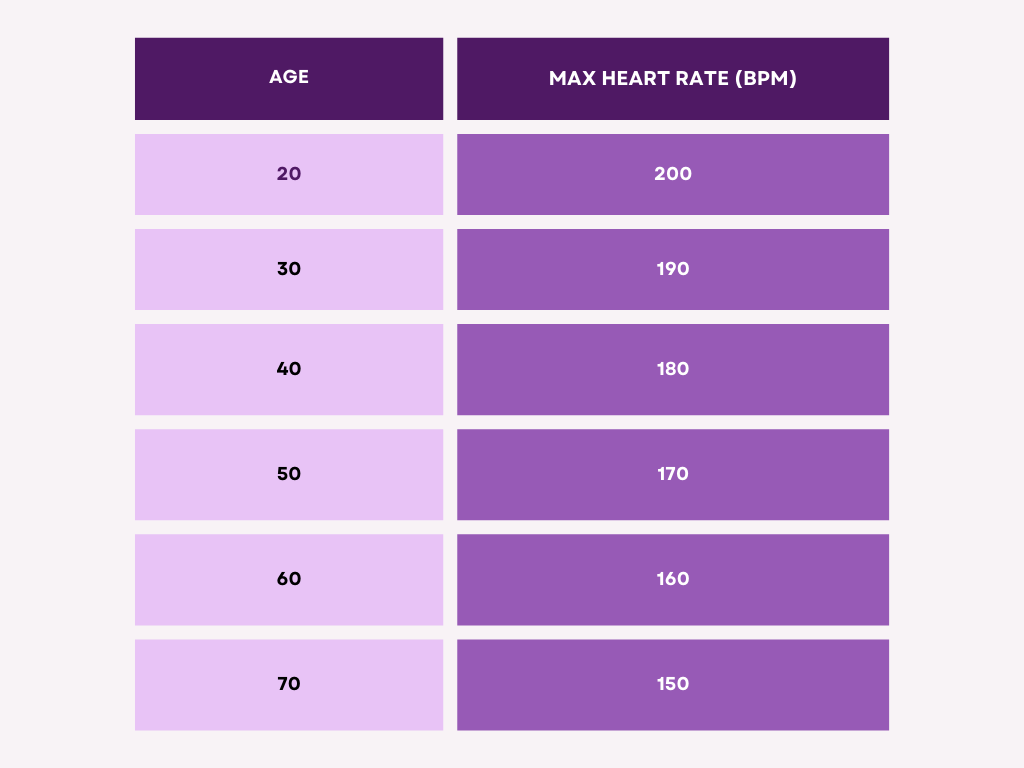TLDR
VO2 max is the gold standard for measuring cardiorespiratory fitness
The most accurate way to measure your VO2 max is at an exercise physiology lab, which you can find easily if you live near a city
In this post, I tell you about my own experience of getting my VO2 max lab-tested
Doing the test was not as hard as I’d imagined
I learned a lot of valuable information about my VO2 max and other health metrics. This helps me understand my current Healthspan Status and informs my cardio exercise plans
If you don’t want to go to a lab, there are other decent options for measuring or estimating your VO2 max
If you are interested in going for a lab test, check out my top tips at the end of this post. I recommend the experience!
What’s VO2 max and why measure it?
As we’ve talked about previously, cardiorespiratory fitness level is perhaps the single most important indicator of longevity.
Cardiorespiratory fitness is also known as aerobic fitness, endurance fitness or cardiovascular fitness - or just ‘cardio’ for short. It refers to how effectively your circulatory and respiratory systems (think heart, blood, lungs) can deliver oxygen to your muscles during physical activity.
Lab testing VO2 max is the gold standard for measuring cardio fitness. It measures the maximum volume (V) of oxygen (O2) your body consumes during exercise. The higher the oxygen uptake, the better.
In the context of the Healthspan Framework, VO2 max is one of the best measurements available to understand our Healthspan Status, plus it can inform our individual approaches to exercise.
Testing for VO2 max
A VO2 max test is commonly administered by health or fitness professionals in an exercise lab.
You run on a treadmill or ride on an exercise bike while the effort required steadily increases. While doing so, you wear a gas analyser mask and a heart rate monitor. Together, the devices will measure your:
Oxygen consumption and carbon dioxide production as you breathe in and out
Breathing rate
Heart rate
Power output.
You’ll run or ride until you can no longer keep up with the ramping level of work required, by which point you’ll have reached your VO2 max. All of this takes up to 15 minutes, depending on how fit you are.
I decided to head to a lab and give it a go …
Before the test
I found a test lab through a combination of internet searching and asking around. If you live near a reasonably sized city, you shouldn’t struggle.
The cost would be $210. I decided to take the test on the exercise bike.
Ideally, you go into your test well rested. Personally, I avoided strenuous exercise but still kept up my normal Sunday morning Ashtanga yoga class and ran around after the kids. My sleep was okay, though not great as I’m currently waking to feed a baby.
I was excited but also nervous about taking the test. How uncomfortable would it feel to be pushed to the limit of my cardio fitness? I read a men’s cycling blog that was quite dramatic about it. It felt a bit like the night before race day.
Getting started
On the day, I met Brendan the exercise physiologist at BodyLab.
In the first part of our appointment, he asked me about my motivation for taking the test and some questions about my health history to screen for risks. After measuring my height and weight, he put a heart rate monitor around my chest and adjusted the exercise bike for my size. Finally he fitted the gas analyser mask, which gets firmly but comfortably strapped around your head, creating a seal with your face.
In front of me were two computer screens worth of charts and dashboards, but there were only a couple of figures I would need to pay attention to. A minute of pedalling to calibrate the equipment and we were ready to start. I was still nervous!
Get set, go!
Actually, things started out very gently. My job was to pedal at my elected rate of 75 rpm (revolutions per minute), as the resistance slowly but surely crept up (if you’re on a treadmill, your job is simply to walk and then run to its pace). This required constant adjustment, which captured my attention and helpfully calmed my nerves. As the test progressed I was cycling harder and could hear my breathing change and the demands on my muscles increase.
Brendan gave me more encouragement as things began to feel harder. I later understood that he could see I’d crossed what is called my lactate threshold, beyond which I wouldn’t be able to continue much longer. Shortly after he encouraged me to go all out, ignoring the 75 rpm target and just giving it everything I could. Moments later, I was done and back-pedalling to cool down. The test took just over 11 minutes.
What I learned … and questions I still had
VO2 max
I returned a VO2 max score of 39.4 ml/kg/min. The report I received from the lab categorised this as ‘Excellent’, being at the 80th percentile for a woman of my age.1
Sounded quite good, but was it really? I still had questions, so I dug a bit deeper:
The relevant ‘Excellent’ range was 39.2-43.9 ml/kg/min. At 39.4, I’d just snuck in
‘Women of my age’ referred to women aged 40-49 years. At 42, I was advantaged by being younger than most of the cohort.
The data doesn’t seem to differentiate between women who are premenopausal, perimenopausal or menopausal, even though women in each of these life stages would appear in the 40-49 year-old cohort. Again, I think I was advantaged.
Comparing my results to the 30-39 year old cohort from which I had fairly recently graduated, I was a high ‘Good’ but well below ‘Excellent’.
Finally, I had to consider the problem of comparing oneself to the general population. By the time many people reach their 30s or 40s, many have been inactive for a decade or more.
Armed with this additional information, I give myself a scorecard of ‘good, but with lots of potential to be better’. As my next increment, I’d love to raise my VO2 max over 40 ml/kg/min.
Maximum heart rate
Another benefit of taking the test was getting a professional reading of my max heart rate, which came in at 177 bpm.
While you can estimate your max heart rate using a formula (220 - [your age] = max hr), predicted and actual results can vary for individuals. Knowing your actual max heart rate will help you hit the best target heart rate zones to get the results you’re looking for from your cardio fitness training.
In my case, an actual max heart rate reading of 177 bpm was very close to the formula’s estimate of 178 bpm. This made me feel very predictable! I did leave wondering whether I could have pushed my heart rate beyond 177 given a little more time at the end of the test.2 Brendan thought probably not and my Apple watch data seems to agree.
Do you need to go to a lab?
You don’t. While lab testing is the most accurate, you have alternatives.
Nowadays, fitness watches, like Apple, Polar or Garmin watches, do a pretty good job of estimating your VO2 max based on your fitness data. My Apple Watch has recorded my VO2 max in the range of 38.6-39.6 ml/kg/min over the past month, which is pretty similar to the lab based result of 39.4 ml/kg/min. I’ve seen others compare lab and watch based results and also return fairly similar results. Brendan the exercise physiologist did warn however that he’s seen cases of significant discrepancy.
You can also use wearable devices like a watch, ideally coupled with a chest strap heart rate monitor, to run your own VO2 max test. You need a safe, flat place to run and like the lab based test you increase your pace over several minutes until you can no longer keep up. Here’s someone ultra-fit taking you through the process.
The Norwegian Institute of Science and Technology has one of the best data collections in the world for VO2 max and provides a formula for calculating your VO2 max by pushing yourself to your limit on a treadmill. You can also try the ‘submaximal’ approach, in which you exercise at a more moderate intensity.3 There are easy to use calculators and great summaries of world leading research on the importance of cardio fitness here too.
I’ve also heard the view that keeping track of how fast you can perform a standardised exercise, like running 800m around a track, is just as good for indicating how your cardio fitness is tracking over time.
For me, going to the lab was a great experience:
I have confidence that the test was done correctly and equipment was accurate
I got to outsource the technical bit to an expert and just concentrate on pedalling. I also appreciated having an expert to talk me through the results
Finally, it was cool to get some of the other information that the testing provides, like my lactate threshold and how much I drew on carbohydrates versus fat at different exercise intensities (more on these things another time).
Given the importance of VO2 max as a metric, I feel the investment of $210 and 90 minutes in the lab were worth it to me. I’ve now got a baseline that I’m confident in, and I might repeat the exercise annually. I also now know that in between, I can use my watch as a reasonably reliable indication of how I’m tracking.
Top tips
If you’re thinking of getting your own VO2 max measured in a lab, here are my tips:
Don’t be nervous, it’s really not that hard. I was overly worried. We’re only talking about a couple of minutes of discomfort. We women are capable of birthing babies … this is a cakewalk by comparison.
Don’t be afraid of finding out your results. It’s all about knowing where we are today and being empowered to improve. If you did find that your VO2 max is below average, you could well have found the single most important piece of information for extending your life and healthspan. That’s well worth knowing.
You don’t need to be an athlete to show up to a lab, despite the photos you might see on the website. All sorts of people go in for these tests.
Take the time up front to ensure that you’ve asked the questions you want to and that the kit is fitting you comfortably. Once you start, you won’t be allowed to pause or to talk.
It can feel weird wearing the mask while working out, but rest assured it is easy to breathe in there.
When the person who is testing you tells you to go all out or push hard, then go absolutely all out. You are practically done. For me, it was a bit frustrating to feel I had something left in the tank.
It’s worth comparing your results against the ACSM data if you’d like a more nuanced view of your results. Consider where you sit in the band in terms of age and VO2 max. If you have follow up questions, email your tester.
If you’ve got a choice between running or cycling, just pick the option that you’re most familiar or comfortable with. I went for the bike because I don’t want to push my pelvic floor at the moment.
You don’t need any fancy gear. Just what you’re comfortable working out in. If you’re on the bike and have proper bike pants, wear them. That seat is kinda uncomfortable and probably designed for a man.
Try to be well rested. Don’t do a hard workout the day before. But don’t stress if your rest hasn’t been perfect. You only have to sustain 6-15 minutes of exercise.
If you’re pregnant, it’s best to wait until after your baby is born and you’re feeling well to take the test. I did it at 8 weeks postpartum on the bike and felt fine.
Go for it and have fun!
If you’ve taken a VO2 max test before or if you’re inspired to do so by this post, then I’d love to hear about your experience.
XX
Toni
The categories from lowest to highest are Very Poor, Poor, Fair, Good, Excellent, Superior (the top 1%). See the charts further down from the Amercian College of Sports Medicine.
Compared to the VO2 max test, where the data showed that we pushed beyond my threshold, we never pushed beyond the max heart rate threshold. My max heart rate was simply the measurement at the moment before I stopped the test.
See https://www.ntnu.edu/cerg/fitness-numbers and scroll down to Peak Exercise Model and Submaximal Exercise Model respectively










Hi Toni. Wow, you are writing this amazing blog with a newborn and a young kid - go you!
I'm currently on a career break living in Germany and am taking this time off to get as healthy as I can. First goal was losing a couple of extra kilos which I thought was age related - turns out not! They just slid off when I improved my lifestyle. I'm working on my fitness - particularly weight training as I have a lot of cardio in my day anyway. Your post has pushed me into getting a skipping rope for interval training. I've researched diet before but what was new to me this time was the importance of insulin and glucose spikes, including intermittent fasting. The glucose goddess and Dr Chatterjee have both been really helpful. Interested to see your diet post when it comes.
Do you recommend the Apple watch for fitness? I've been on the fence as I try to avoid too many gadgets.
Melody
Thanks mate! Have been wanting to track and you’ve made this way more accessible.